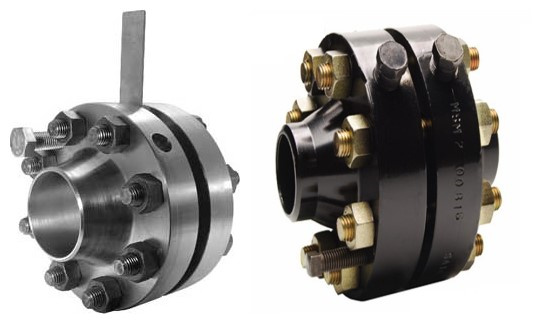
Orifice Flange
Orifice Flanges Definition:
Orifice Flanges are used with orifice meters for the purpose of measuring the flow rate of either liquids or gases in the respective pipeline. Pairs of pressure “Tappings”, mostly on 2 sides, directly opposite each other, are machined into the orifice flange. This makes separate orifice carriers or tappings in the pipe wall unnecessary.
Orifice Flanges Facing Types:
Orifice Flanges generally come with either Raised Faces or RTJ (Ring Type Joint) facings. They are, for all intensive purposes, the same as weld neck and slip-on flanges with extra machining.The image on the right shows a set Orifice Flanges, where a Orifice Plate is mounted and a jack screw is machined. This jack screw is used to facilitate separating the flanges for inspection or replacement of the Orifice Plate and gaskets.
Orifice Flanges Size:
The range of orifice flanges covers all standard sizes and ranges, and all common flange materials. Flanges are available in Welding Neck, Slip On, and Threaded form, and are typically supplied with two 1/2″ NPT tappings in each flange.
ASME B16.36 covers Dimensions and dimensional tolerances from orifice flanges (similar to those covered in ASME B16.5) that have orifice pressure differential connections. Coverage is limited to the following flanges:
Welding Neck Classes 300, 400, 600, 900, 1500, 2500
Slip On Class 300
Threaded Class 300
Orifice Flanges Application:
Orifice flanges are for metering the volumetric flow rate of liquids and gasses through a pipe. Two orifice flanges are called an orifice flange union. Each flange comes with two pipe taps for measuring the pressure drop of the flow through an orifice plate. Orifice plates do not come with the flanges and are sized based on the requirements of the process. Two jack screws are used to spread the flanges apart in order to change the orifice plate. This flange is normally available in weld neck, slip-on, and threaded flanges. These flanges have a raised face.
Orifice flanges are installed in a straight run of pipe in order to avoid turbulence at the plate. As a rule of thumb, an orifice flange has ten diameters of straight pipe upstream and five diameters of pipe downstream. There are guidelines set out in (American Gas Association) AGA Report #3 which is the Orifice Metering of Natural gas.
When installing the orifice plate flange the pressure taps need to be at the same elevation to each other. The assumption when making the calculation for the orifice plate is that static head of the tubes is the same on both sides of the orifice plate. Pressure taps should not be installed facing down as the taps could become plugged with debris in the line.
Weldneck orifice flanges are butt-welded into the pipeline. The inside diameter (bore diameter) of the pipe should be specified when ordering. Weldneck orifice flanges are available in ANSI classes 300, 600, 900, 1500 and 2500. They are not available in ANSI 150 sizes because the thickness of ANSI 150 flanges are not enough to allow for drilling pressure taps.







